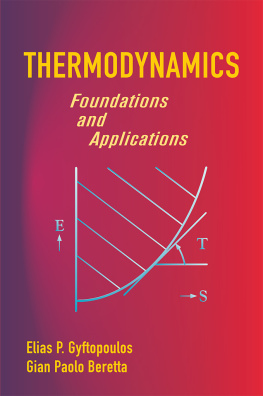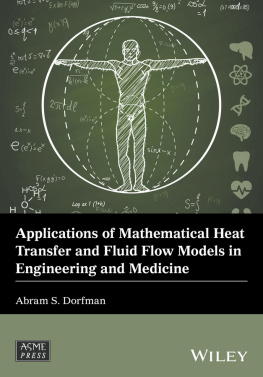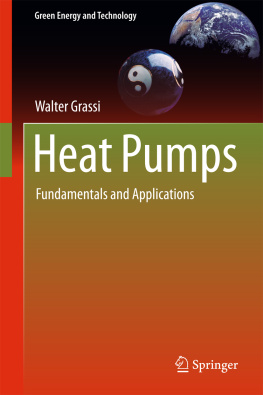THERMODYNAMICS
Foundations and Applications
THERMODYNAMICS
Foundations and Applications
E LIAS P. G YFTOPOULOS
Massachusetts Institute of Technology
G IAN P AOLO B ERETTA
University of Brescia
DOVER PUBLICATIONS, INC.
Mineola, New York
Copyright
Copyright 1991, 2005 by Elias P. Gyftopoulos and Gian Paolo Beretta All rights reserved.
Bibliographical Note
This Dover edition, first published in 2005, is an augmented and corrected republication of the work originally published by Macmillan Publishing Company, New York, in 1991. For the Dover edition, the authors have made numerous corrections to the body of the text and have added one table and 97 pages of Problem Solutions.
Library of Congress CataloginginPublication Data
Gyftopoulos, E. P.
Thermodynamics : foundations and applications / Elias P. Gyftopoulos, Gian Paolo Beretta.
p. cm.
An augmented and corrected republication of the work originally published by Macmillan Publishing Company, New York, in 1991T.p. verso.
Includes index.
ISBNN 0486439321 (pbk.)
1. ThermodynamicsTextbooks. I. Beretta, Gian Paolo. II. Title.
QC311.G994 2005
536'.7dc22
2004061878
Manufactured in the United States of America
Dover Publications, Inc., 31 East 2nd Street, Mineola, N.Y. 11501
We dedicate this book
to our teacher of thermodynamics,
George N. Hatsopoulos
Preface
In view of the large number of books on thermodynamics it may seem surprising that there should be any need for yet another, wrote Guggenheim in the preface of his book Thermodynamics in 1949. Many more books on thermodynamics have been published since then. So, why are we adding ours to the long list of entries on the subject?
During the past two decades of teaching thermodynamics to students from all over the globe, we have sensed a widespread quest for more clarity, unambiguity, and logical consistency in the exposition of the foundations than are available in traditional presentations. In response to our students demand, we have gradually developed a set of arguments, observations, definitions, statements, and derivations that cannot be found in any of the books currently available. Continuing the effort pioneered by Keenan and Hatsopoulos, we have composed an exposition of the foundations and the applications of thermodynamics that many enthusiastic M.I.T. students have found clarifying, rewarding, and inspiring. Our class notes have grown into a coherent collection thoroughly tested in the classroom, equipped with a large number of homework problems, and mature enough for wider dissemination.
In the preface of his book Concepts of Thermodynamics in 1960, Obert wrote: Most teachers will agree that the subject of engineering thermodynamics is confusing to the student, despite the simplicity of the usual undergraduate presentation. In our experience, the major source of confusion is the lack of logical consistency and completeness in the many presentations of the foundations of thermodynamics. The definition of a system as just the subject of analysis or anything that is enclosed by a surface in space is incomplete. The definition of properties in terms of the state is circular if the definition of state is in terms of the properties. The definition of heat as anything that is not work is incomplete and ambiguous. The definition of thermal equilibrium in terms of temperature is circular if the definition of temperature is in terms of thermal equilibrium. The restriction to equilibrium states is artificial if the purpose is the use of heat and cycles to define entropy. Even if entirely uninterested in the foundations, the student cannot avoid but sense this ambiguity and lack of logical consistency and develop the incorrect conviction that thermodynamics is a confusing, ambiguous, hand waving subject. Unfortunately, such a conviction is quite widespread and very difficult to dismantle.
The problem is not resolved even by recent books for engineering students such as the excellent textbooks on thermodynamics by F. F. Huang (1988 edition), K. Wark, Jr. (1988 edition), and M. J. Moran and H. N. Shapiro (1988), which tend to deemphasize the subtleties of the foundations by placing the emphasis on the applications of energy and entropy balances. The student encounters no difficulty in mastering the mechanics of energy and entropy balances. But the conviction that thermodynamics is based on ambiguous grounds remains. In our view, this hinders comprehension and discourages any desire to further explore and exploit the wide range of implications and applications of the subject.
In the novel exposition of the foundations that we present, we strive to develop each of the basic concepts in full detail and without ambiguities, at a level that assumes a sophomore background in calculus and elementary physics. Some characteristic features are as follows.
- The basic concepts and principles are introduced in a novel logical sequence that eliminates the traditional problem of incomplete definitions and vicious circles.
- The carefully worded statements of the laws of thermodynamics are presented as fundamental laws of physics that complement the laws of dynamics.
- The principles and results are developed for both macroscopic and microscopic systems, and for both equilibrium and nonequilibrium states.
- The concept of entropy is defined for any system, including a system with a single degree of freedom, and for any state, including a nonequilibrium state.
- The state principle is derived as an exact and rigorous result valid for any stable equilibrium state of any system.
- The concept of temperature is defined for the stable equilibrium states of any system, including a system consisting of one particle with a single degree of freedom.
- The concepts of work and heat are defined in terms of the concepts of energy and entropy exchanges and not vice versa.
- The third law is introduced in a novel discussion of the lowest-temperature stable equilibrium states.
- The principles and results are illustrated pictorially on a novel graph of energy versus entropy.
- A concise but precise summary of the foundations provides a suitable starting point for a first introductory undergraduate course.
- The validity of the Euler relation for relatively large values of the amounts of constituents is derived from a rigorous and novel definition of a simple system.
- The derivations of relations among properties of simple systems are made easy to follow by showing explicitly all the functional dependences.
- The chemical equilibrium equation is derived from a rigorous and novel discussion based on the definition of a simple system.
- The typical endofchapter problems that test each new concept are complemented by a large number of more structured problems designed to test the connections between new concepts and concepts introduced in earlier chapters.
A part of the book is intended for use as a text for an introductory undergraduate course in thermodynamics. Other parts provide material for more advanced courses, including a graduate course with emphasis on the foundations. We discuss suggestions for this partitioning at the end of .
In undergraduate path, an advanced undergraduate path with emphasis on applications, a graduate path with emphasis on advanced topics, and a graduate path with emphasis on the general foundations. For each path we suggest the study of different chapters.
In we discuss the key concepts and fundamental principles of thermodynamics. In doing so, we assume that concepts and principles such as space, time, reference frame, velocity, acceleration, force, mass, force field, gravitational acceleration, electrostatic field, magnetic field, momentum, kinetic energy, potential energy, Newtons laws, and Maxwells equations are all part of the educational background of our reader in mechanics and electromagnetism at an advanced high school or introductory college level. We require this background not because we discuss any complicated issues of these facets of natural science but because it is part of the conceptual underpinning of thermodynamics.










